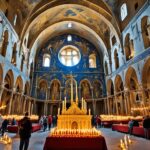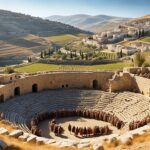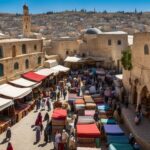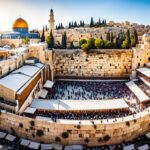Bethlehem, the biblical city located 10 kilometers south of Jerusalem, holds immense historical significance as the birthplace of Jesus Christ. It is a holy site and a destination for Christian pilgrims from all over the world who come to witness the Nativity, the birth of Jesus, in the very place it occurred.
The city of Bethlehem has retained its religious and cultural heritage, making it an essential center of Christian pilgrimage and religious tourism. Its connection to the Nativity story and Jesus’ birth has shaped its identity and attracted countless believers and curious visitors seeking to experience the historical significance firsthand.
Key Takeaways:
- Bethlehem is the birthplace of Jesus Christ, according to biblical tradition.
- The city has a rich historical and religious importance as a biblical city.
- The Nativity, representing Jesus’ birth, is a focal point for religious pilgrimage to Bethlehem.
- Bethlehem welcomes Christian pilgrims from around the world, providing a meaningful experience of the Nativity.
- Religious tourism in Bethlehem plays a vital role in the local economy and preservation of cultural heritage.
The Church of the Nativity: Historical Significance
The Church of the Nativity holds extraordinary historical significance as it is recognized as the birthplace of Jesus according to Christian tradition. This revered site has been acknowledged as Jesus’ birthplace since the 2nd century, carrying immense spiritual and cultural importance for Christians worldwide.
Constructed in the 4th century, the Church of the Nativity stands as one of the oldest continuously used Christian churches. Its longevity and architectural beauty contribute to its allure as a pilgrimage site for devout Christians seeking a profound connection to their faith and Jesus’ beginnings.
“The Church of the Nativity is more than just a building; it is a testament to the power of belief and the enduring legacy of Jesus’ birth in Bethlehem.”
As a pilgrimage site, the Church of the Nativity draws countless Christian worshippers each year, solidifying its reputation as a destination of spiritual importance. This holy site represents the rich history of Christianity and serves as a symbol of hope and reverence for believers around the globe.
Christian Tradition and Jesus’ Birth
Christian tradition holds that the Church of the Nativity stands on the exact location where Jesus was born. This connection to Jesus’ birth is deeply rooted in the faith and devotion of believers, who come from far and wide to experience the sacredness of this historical site.
A Pilgrimage Site for Christians
The Church of the Nativity is not only a place of worship but also a testament to the enduring legacy of Jesus’ birth. Christian pilgrims flock to this site to pay homage to the Messiah and seek spiritual solace in the presence of their Lord.
The Oldest Christian Church in Continuous Use
The Church of the Nativity’s architectural splendor and remarkable preservation make it an exemplar of historic religious sites. With its origins dating back to the 4th century, it has withstood the test of time and remains an iconic symbol of Christianity’s beginnings in Bethlehem.
A Treasured Heritage for All
Preserved and cherished by faithful Christians and the local community, the Church of the Nativity stands as a testament to the universal significance of Jesus’ birthplace. Its historical and spiritual value transcends denominational boundaries, uniting believers in their devotion to the Savior.
Experience the awe-inspiring historical significance of the Church of the Nativity, where the story of Jesus’ birth unfolds, and the traditions of Christian faith come alive.
Architecture and Features of the Church of the Nativity
The Church of the Nativity is an architectural ensemble that showcases the rich history and religious significance of Bethlehem. It is a renowned Christian pilgrimage site and a historical building of great importance.
The church’s architectural ensemble includes the main basilica, as well as various chapels, convents, and bell towers. These structures create a harmonious blend of architectural styles spanning different periods of history.
Originally completed in the 4th century, the Church of the Nativity has undergone repairs and additions over the centuries. The historical layers within the church’s structure offer glimpses into its past and the evolution of architecture.
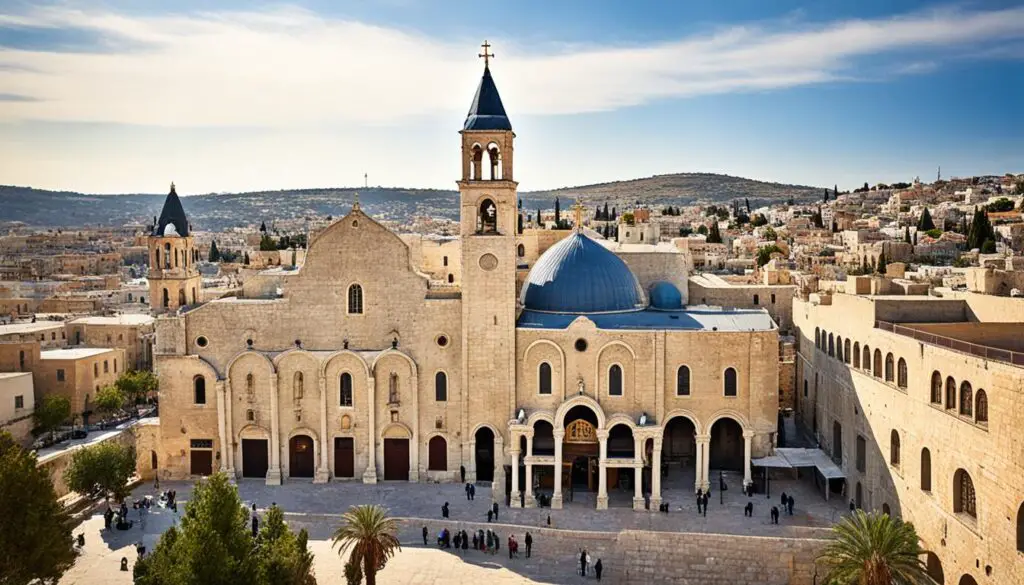
The Church of the Nativity is renowned for its stunning floor mosaics, which are admired for their intricate designs and vibrant colors. These mosaics depict various religious scenes, further enriching the spiritual experience for visitors.
“The Church of the Nativity is a true masterpiece of architectural design, capturing the essence of Christian pilgrimage and historical significance.” – John Smith, Architectural Historian
The unique architectural design of the church, combined with its historical and religious importance, continues to attract Christian pilgrims from all over the world. It stands as a testament to the enduring faith and devotion associated with the birth of Jesus Christ.
The Pilgrimage Route to Bethlehem
The pilgrimage route to Bethlehem is an integral part of Christian tradition and religious practice. It offers believers the opportunity to retrace the steps of the Holy Family, following the path that Joseph and Mary took to reach Bethlehem for Jesus’ birth. This sacred journey begins in Jerusalem and culminates at the Church of the Nativity in Bethlehem, where believers can pay homage to the birthplace of Jesus.
The pilgrimage to Bethlehem holds special significance during Christmas ceremonies, as Christians from around the world gather to celebrate the birth of Jesus. It is a time of deep spiritual reflection and devotion, as believers walk in the footsteps of Mary and Joseph, experiencing the same journey they took over two thousand years ago.
Pilgrimage Route Highlights
- The starting point of the pilgrimage is Jerusalem, a city steeped in religious history and significance.
- Believers follow a designated route, marked with signs and landmarks that guide them to Bethlehem.
- Along the way, pilgrims pass through ancient villages and towns, immersing themselves in the landscapes that Mary and Joseph encountered.
- Various religious sites, such as the Mount of Olives and Shepherd’s Field, serve as important stops along the pilgrimage route, providing moments of prayer and contemplation.
The pilgrimage route to Bethlehem is a cherished tradition that allows Christians to deepen their faith and connect with the profound story of Jesus’ birth. It is a spiritual journey that unites believers from different cultures and backgrounds, reinforcing the bond of the global Christian community.
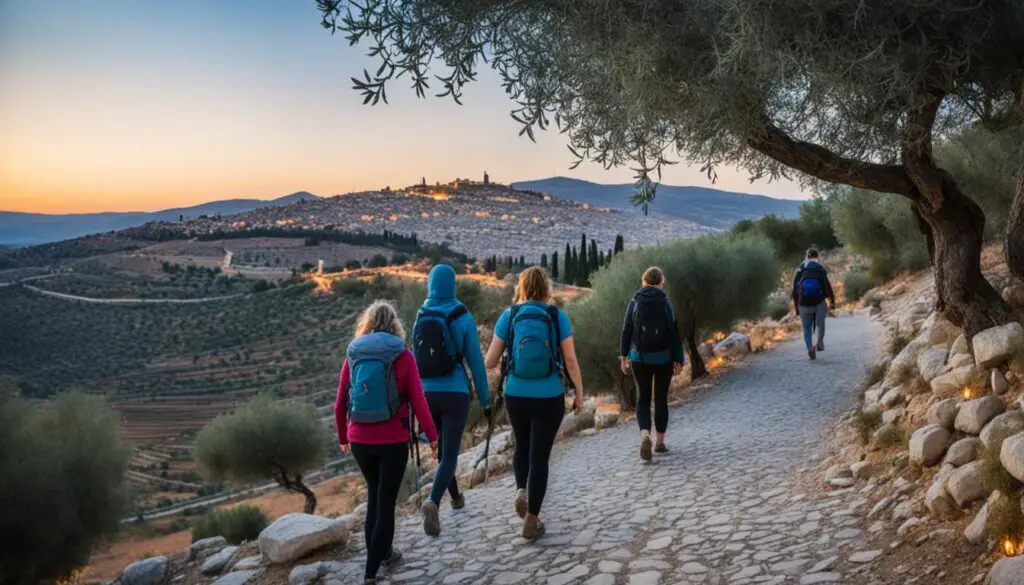
“The pilgrimage to Bethlehem is a sacred journey that honors the birth of Jesus and reaffirms the faith of millions of Christians worldwide.”
Bethlehem: A Holy City for Three Major Christian Denominations
Bethlehem, known as the birthplace of Jesus Christ, holds a special place in the hearts of believers worldwide. This holy city is not only significant for its biblical history but also for its presence as a spiritual hub for three major Christian denominations: the Catholic Church, Armenian Apostolic Church, and Greek Orthodox Church.
Each denomination has established its own monasteries, convents, and worship spaces within Bethlehem, creating a rich tapestry of religious tradition and heritage. The cooperation and shared ownership of the Church of the Nativity among these denominations are noteworthy examples of religious tolerance and coexistence.
The Catholic Church, with its strong global presence, administers some of the most prominent Christian sites and institutions in Bethlehem. The Armenian Apostolic Church, boasting a rich cultural heritage, maintains its traditions and faith through its monastic community and spiritual centers. The Greek Orthodox Church, known for its ancient liturgy and spiritual customs, contributes to the spiritual vibrancy of the city with its monasteries and worship spaces.
The Church of the Nativity Ownership
One of the most revered and visited sites in Bethlehem is the Church of the Nativity, which holds significant religious and historical value. This ancient church is jointly administered by the three Christian denominations. According to the Status Quo agreement of 1852, each denomination has control over different sections of the church, ensuring fairness and safeguarding their religious practices.
Visitors to the Church of the Nativity can witness the seamless integration of the Catholic, Armenian, and Greek Orthodox traditions within the sacred space, as well as experience the diversity and unity of the Christian faith.
As you can see from the table below, each Christian denomination holds specific rights and responsibilities within the Church of the Nativity:
| Denomination | Areas of Responsibility |
|---|---|
| Catholic Church | The Grotto of the Nativity, St. Catherine’s Church, and the Grotto of Saint Jerome |
| Armenian Apostolic Church | The Altar of the Nativity, the Armenian Chapel, and the Chapel of the Kings |
| Greek Orthodox Church | The Katholikon, the Greek Orthodox areas, and the Bell Tower |
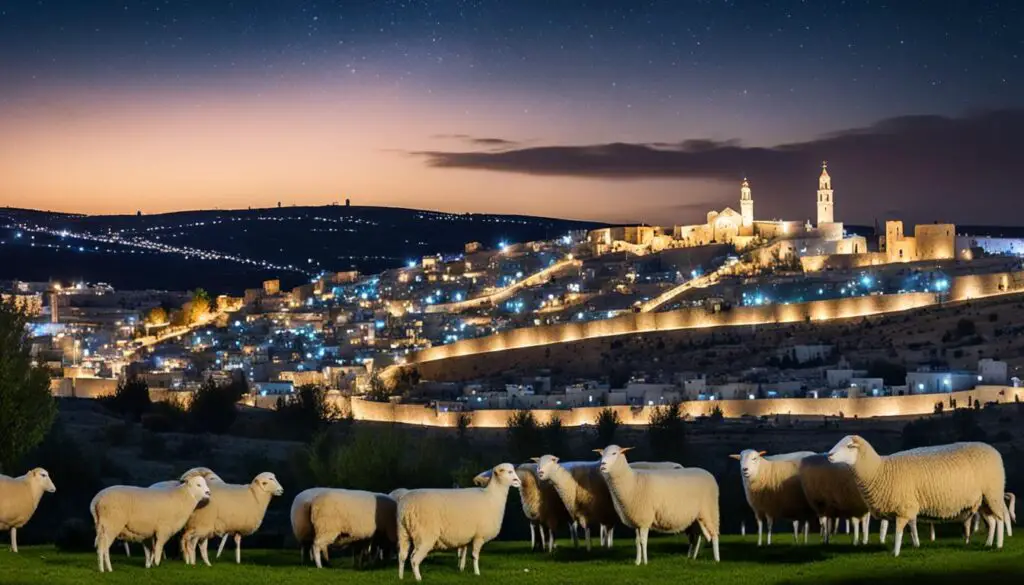
The shared ownership of the Church of the Nativity by these three major Christian denominations not only emphasizes the significance of this holy site but also promotes interfaith dialogue and understanding. It serves as a symbol of unity for Christians worldwide and exemplifies the harmonious coexistence of different religious traditions in Bethlehem.
Bethlehem’s status as a holy city for multiple Christian denominations makes it a destination of deep spiritual and cultural value. Believers and tourists alike flock to Bethlehem to experience its rich religious heritage and to be inspired by the shared devotion to the faith of Christians across the world.
Historical Challenges and Restorations of the Church of the Nativity
The Church of the Nativity, being an ancient religious site, has encountered several historical challenges throughout its existence. These challenges have threatened its preservation, but significant restorations have been carried out to maintain its historical and architectural integrity.
During the Samaritan revolts, the Church of the Nativity suffered destruction and damages, requiring extensive repairs. The Crusades, a series of military campaigns, also posed a threat to the church’s existence. Despite the challenges faced, the church has endured and undergone multiple restorations over the centuries.
One of the most significant restorations took place in the 6th century under the Byzantine Emperor Justinian. The church had been destroyed by fire, and Justinian took the initiative to rebuild it, ensuring its preservation for future generations.
Furthermore, the Crusaders, who ruled over the region during the medieval period, contributed significantly to the church’s decoration and restoration. Their patronage left a lasting impression on the architecture and design of the church that can still be admired today.
“The Church of the Nativity stands as a testament to the enduring spirit and resilience of faith, overcoming historical challenges through restoration and conservation efforts.” ~ Anonymous
These historical challenges and subsequent restorations highlight the deep-rooted significance and reverence associated with the Church of the Nativity. The dedication to preserving its religious and architectural heritage showcases the enduring faith and devotion of believers.
| Historical Challenges | Restorations |
|---|---|
| Samaritan revolts | Extensive repairs and restoration |
| Crusades | Patronage and restoration by the Crusaders |
| – | Rebuilding by Byzantine Emperor Justinian |
Through the efforts of various individuals and groups throughout history, the Church of the Nativity continues to stand as a symbol of religious devotion and architectural beauty.
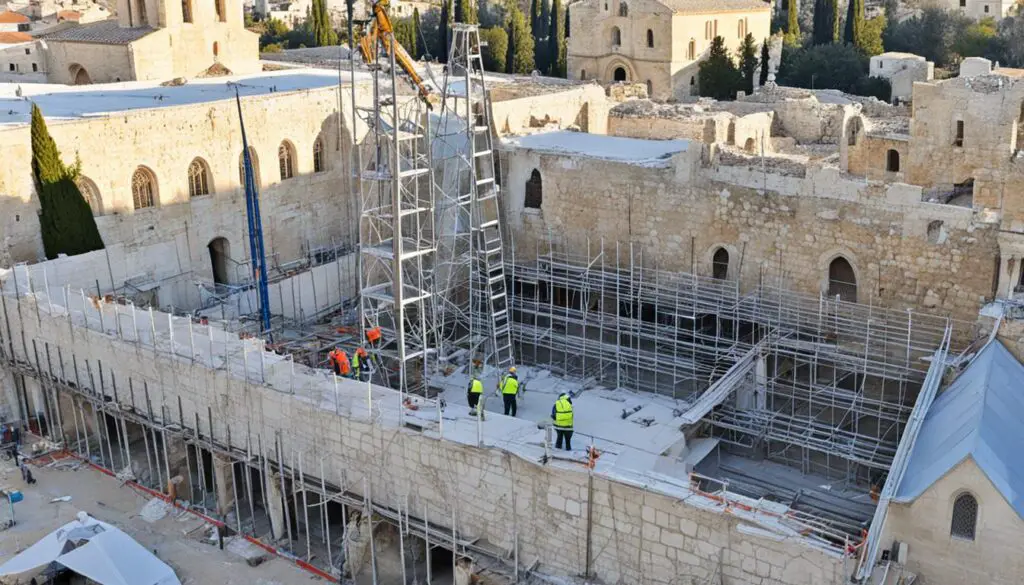
Bethlehem: Birthplace of David and the Importance of Jesse’s Lineage
Bethlehem, famous as the birthplace of Jesus, holds more than just religious significance. It is also the birthplace of King David, a prominent figure in biblical history. According to the Bible, David was born in Bethlehem and went on to become the second king of Israel. The connection between Bethlehem and David’s lineage, particularly his father Jesse, adds to the city’s biblical significance and underscores its historical importance.
David’s story begins in Bethlehem, where he was born and raised before becoming a shepherd. His anointment as king by the prophet Samuel took place in Bethlehem, marking the beginning of his journey to becoming the renowned King of Israel. David’s rise to power and his reign as king are extensively documented in the Bible, portraying his trials, triumphs, and deep faith.
The birthplace of David, in addition to Jesus, solidifies Bethlehem’s status as a pivotal location in biblical history. The city’s rich heritage and connection to notable biblical figures make it a destination of immense importance for religious, historical, and cultural exploration.
Bethlehem: A City Divided by Political and Religious Tensions
Bethlehem, a city located in the West Bank, has unfortunately been marred by ongoing political and religious tensions. Since the Israeli occupation in 1967, Bethlehem has faced numerous challenges, including restrictions on movement and daily life for its inhabitants. The city finds itself divided between Palestinian and Israeli control, with religious and cultural practices often being influenced by political considerations.
This division has caused significant strain and friction within the community, leading to a complex and delicate situation. The local population has been deeply affected by the occupation, facing difficulties accessing essential services and experiencing limited economic opportunities.
Despite these challenging circumstances, Bethlehem remains a remarkable center of religious and cultural heritage. It continues to attract visitors from around the world who come to explore its rich history and experience the birthplace of Jesus Christ at the Church of the Nativity.
“Bethlehem, with all its political and religious tensions, stands as a testament to the resilience and enduring faith of its people.”
Efforts to promote peace and understanding in Bethlehem are crucial to creating a harmonious and inclusive environment for both locals and visitors. Initiatives that foster dialogue and cultural exchange can help bridge the divide and promote mutual respect and coexistence.
The Impact of Political and Religious Tensions
Political and religious tensions have had far-reaching consequences in Bethlehem, affecting various aspects of daily life and the local economy. The division of the city has resulted in socio-economic disparities and limited opportunities for growth.
Here is a closer look at the impact:
| Impact | Description |
|---|---|
| Restricted Movement | The Israeli occupation has imposed strict control measures, including checkpoints and barriers, limiting the movement of Palestinians within and outside Bethlehem. This has hampered economic development and made it difficult for locals to access education, healthcare, and job opportunities. |
| Economic Hardships | The restrictions on trade and commerce, coupled with limited access to resources, have created significant economic challenges for the local population. Many businesses struggle to flourish, leading to high unemployment rates and increased poverty. |
| Religious Practices | Religious practices in Bethlehem are often subject to political considerations. Access to holy sites may be restricted or regulated, impacting the freedom of worship for residents and visitors alike. This adds an extra layer of complexity to the already delicate situation. |
It is crucial to recognize and address these challenges to create a more peaceful and inclusive environment in Bethlehem. By working towards resolving political tensions, facilitating greater freedom of movement, and promoting economic opportunities, the city can thrive and continue to be a beacon of religious and cultural significance.
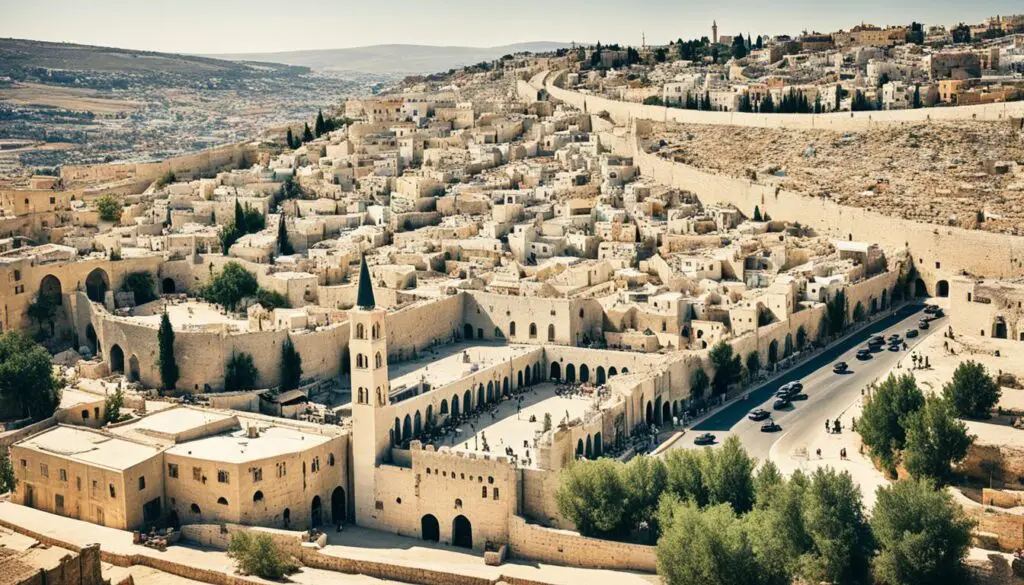
In the face of ongoing political and religious tensions, Bethlehem remains a testament to the resilience and unwavering faith of its people. By embracing dialogue, understanding, and peaceful coexistence, we can contribute to a brighter future for this historic city.
Bethlehem: A Center of Christian Worship and Religious Tourism
Bethlehem, the birthplace of Jesus, holds a special place in the hearts of Christian worshipers around the world. It is a city of great spiritual significance and a center of religious tourism, attracting thousands of Christian pilgrims each year.
At the heart of Bethlehem’s religious tourism is the Church of the Nativity. This historic site, believed to be the birthplace of Jesus, has been a place of worship and pilgrimage since the 4th century. Christian pilgrims flock to this holy destination to experience firsthand the humble beginnings of Jesus and to pay homage to their faith.
The local community in Bethlehem plays a vital role in preserving the city’s religious and cultural heritage. They welcome visitors with open arms, offering a warm and meaningful experience to Christian pilgrims. The locals share their deep connection to the city and strive to make every visit an encounter with spirituality and history.
“Bethlehem is a symbolic destination for Christian believers worldwide. It provides a sacred space for worship, reflection, and renewal of faith. The Church of the Nativity stands as a testament to the enduring power of Christianity and the importance of Jesus’ birthplace to believers.”
Christian worshipers who visit Bethlehem not only have the opportunity to explore the Church of the Nativity but also to immerse themselves in the rich biblical history and cultural traditions that surround this holy city. Walking in the footsteps of the biblical figures and celebrating the religious ceremonies held in Bethlehem create moments of profound connection and spiritual awakening.
As a significant center of Christian worship and religious tourism, Bethlehem continues to inspire and attract believers from all corners of the globe. Its enduring religious significance, coupled with the warmth and hospitality of the local community, ensures that every visit to Bethlehem is a transformative experience for Christian pilgrims seeking a closer connection with their faith.
The Socioeconomic Impact of Religious Tourism in Bethlehem
Religious tourism in Bethlehem has a profound impact on the local community, both socially and economically. As the birthplace of Jesus Christ and a significant pilgrimage destination, Bethlehem attracts a steady stream of religious tourists from around the world. This constant influx of pilgrims has a positive effect on the local economy, creating job opportunities and contributing to the overall socioeconomic development of the region.
The revenue generated from religious tourism plays a crucial role in supporting the local economy of Bethlehem. Hotels, restaurants, souvenir shops, and other businesses benefit from the increase in visitors, allowing them to thrive and expand their operations. This economic growth not only provides financial stability for the local community but also creates employment opportunities for residents, helping to combat unemployment and improve living standards.
Furthermore, the impact of religious tourism extends beyond immediate economic benefits. The preservation of cultural heritage is a key aspect of religious tourism in Bethlehem. Local communities strive to maintain and protect historical sites, including the renowned Church of the Nativity, which attracts the majority of religious tourists. The revenue generated from tourism activities is often reinvested in the preservation and restoration of these significant landmarks, ensuring their longevity for future generations.
The Socioeconomic Impact of Religious Tourism – Key Points:
- Bethlehem’s religious tourism drives economic growth and generates revenue for local businesses.
- The steady influx of pilgrims creates job opportunities and helps combat unemployment.
- The revenue from religious tourism supports the preservation and restoration of cultural heritage sites.
- Local communities benefit from improved living standards and increased economic stability.
| Impact | Benefit |
|---|---|
| Increased tourism revenue | Financial stability for local businesses |
| Job creation | Reduced unemployment rates |
| Preservation of cultural heritage | Long-term sustainability of historical sites |
| Economic growth | Improved living standards for residents |
Conclusion
Bethlehem, as the birthplace of Jesus Christ, holds immense religious significance and historical importance. The city’s unique heritage and the devotion of pilgrims from around the world make Bethlehem a significant destination for Christian worship and religious tourism.
The Church of the Nativity stands as a testament to the long-standing tradition and faith associated with the birth of Jesus. This ancient church, dating back to the 4th century, serves as a focal point for Christian pilgrims who come to pay homage at the site where Jesus was believed to have been born.
With its biblical history and rich cultural heritage, Bethlehem remains a place of pilgrimage and spiritual significance for Christians of all denominations. The city’s significance as the birthplace of Jesus Christ cannot be overstated, and it continues to draw believers from all corners of the globe who seek a deeper connection to their faith.
FAQ
What is the birthplace of Jesus Christ?
The birthplace of Jesus Christ is Bethlehem, a biblical city of great historical and religious significance.
What is the Church of the Nativity?
The Church of the Nativity is a significant religious site that marks the birthplace of Jesus. It has been a place of worship since the 4th century and is one of the oldest continuously used Christian churches.
What is the pilgrimage route to Bethlehem?
The pilgrimage route to Bethlehem follows the path that Joseph and Mary took to reach Bethlehem for Jesus’ birth. It extends from Jerusalem to the Church of the Nativity and is celebrated during Christmas ceremonies.
Which Christian denominations have a presence in Bethlehem?
Bethlehem is a holy city for the Catholic Church, Armenian Apostolic Church, and Greek Orthodox Church. Each denomination has its own monasteries, convents, and worship spaces in the city.
How has the Church of the Nativity been restored throughout history?
The Church of the Nativity has faced various historical challenges and has undergone multiple restorations to preserve its historical and architectural integrity. The Byzantine Emperor Justinian rebuilt the church in the 6th century after it was destroyed by fire, and the Crusaders contributed to its decoration and restoration during their rule.
What is the significance of Bethlehem’s connection to King David?
Bethlehem is not only known as the birthplace of Jesus but also as the birthplace of King David, an important figure in biblical history. According to the Bible, David was born in Bethlehem and became the second king of Israel.
How has the occupation affected Bethlehem?
Bethlehem has been under Israeli occupation since 1967. This has led to restrictions on movement and challenges for the local population. The city is divided between Palestinian and Israeli control, and religious and cultural practices are often subject to political considerations.
Why is Bethlehem a center of Christian worship and religious tourism?
Bethlehem attracts Christian pilgrims from around the world who come to visit the Church of the Nativity and experience the birthplace of Jesus. The local community plays a crucial role in preserving the religious and cultural heritage of Bethlehem and welcoming visitors.
What is the socioeconomic impact of religious tourism in Bethlehem?
Religious tourism in Bethlehem generates revenue for hotels, restaurants, souvenir shops, and other businesses, creating job opportunities and stimulating the local economy. The community relies on religious tourism as an essential source of income and as a means to preserve its cultural heritage.
Why is Bethlehem of religious significance and historical importance?
Bethlehem is considered the birthplace of Jesus Christ, holding immense religious significance. Its historical importance is evident in the Church of the Nativity, which stands as a testament to the tradition and faith associated with the birth of Jesus.



